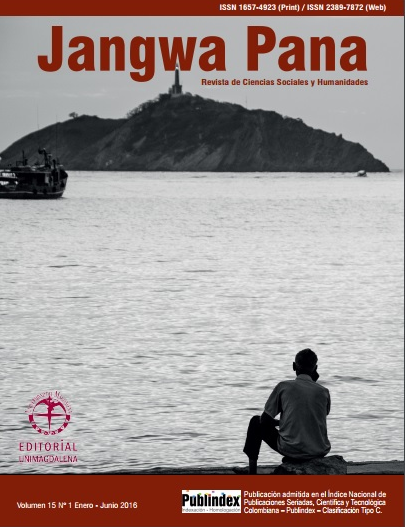Indios and empedrados sotaquireños
Main Article Content
Abstract
Downloads
Article Details
References
Alfonzo, N. & Pérez, E. (2008). Diálogo de saberes y proyectos de investigación en la escuela. Educere, 12, (42) 455-460. Recuperado de http://www.redalyc.org/articulo.oa?id=35614569005
Bedoya-Ramírez, J. (2015). Las prácticas culturales de los ropavejeros de la plaza españa de Bogotá. Jangwa Pana, 14, 90-98.
Concejo Municipal de Sotaquira. (2014). Acuerdo No. 002 (1) Recuperado de http://sotaquira-boyaca.gov.co/apc-aa-files/36373932393035656137653436376438/acuerdo-002-2014-declara-a-los-indios-sotaquireos-comp-patrimonio-cultural-sotaquira-boyaca.pdf
Fonseca-Reyes, Á. (2014). El poblado del soberano: memorias de un viaje a la profunidad de sus tradiciones y sus gentes. Rastros Rostros, 16(30), 105- 114.
Freire, P. (1996). Pedagogía de la autonomía. México D. F.: Siglo XXI Editores.
Freire, P. (1997). Cartas a quien pretende enseñar. México D. F.: Siglo XXI Editores.
García, C. (1990). Culturas Híbridas. Estrategias para entrar y salir de la modernidad. México D. F.: Grijalbo S. A.
Grupo Semillas. (2013). ¡Ya viene la nueva 970 recargada! Las leyes que privatizan y controlan el uso de las semillas, criminalizan las semillas criollas. Grain. Recuperado de https://www.grain.org/es/article/entries/4821-ya-viene-la-nueva-970-recargada-las-leyes-que-privatizan-y-controlan-el-uso-de-las-semillas-criminalizan-las-semillas-criollas
Guerrero, P. (2002). Guía etnográfica para la sistematización de datos sobre la diversidad y la diferencia de culturas. Quito: Abya.Yala.
Jaccard, N. (2012). La bomba transgénica. Revista semana. Recuperado de http://www.semana.com/vida-moderna/articulo/la-bomba-transgenica/265431-3
Restrepo, E. (2007). Identidades: Planteamientos teóricos y sugerencias metodologías para su estudio. Jangwa Pana, 5, 24- 35.
Rengifo, G. (2008). Educación y diversidad cultural. Los oficios campesinos. Lima: Bellido Ediciones EIRL.
Semana. (2013). La historia detrás del 970. Revista Semana. Recuperado de http://www.semana.com/nacion/articulo/la-historia-detras-del-970/355078-3
Suárez, A. (2015). Los indios sotaquireños, manjar de los dioses. El espectador. Recuperado de http://blogs.elespectador.com/coma-cuento-cocina-sin-enredos/2015/04/18/los-indios-sotaquirenos-manjar-de-los-dioses/
Warnier, J.P. (2001). La mundialización de la cultura. (M. Guerrero, Trad.) Quito: Abya-Yala.
Zuleta, I. (2013). Tener una semilla es un delito: la nueva dictadura alimentaria. El Espectador. Recuperado de http://www.elespectador.com/opinion/tener-una-semilla-un-delito-nueva-dictadura-alimentaria-columna-439703

